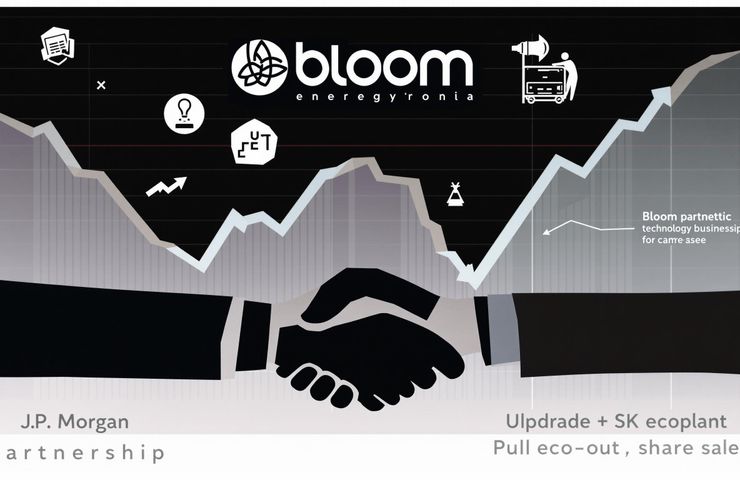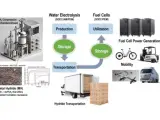
Fuel Cell Frenzy: Bloom Energy Stock Rides J.P. Morgan High, Then Tumbles on SK ecoplant Exit
July 11, 2025Bloom Energy just took clean tech investors on an emotional rollercoaster—racing up one day, slamming into a wall the next.
Big Win on Wall Street… For a Minute
On July 9, 2025, Bloom Energy (NYSE: BE) saw its stock shoot up nearly 18%. What lit the rocket? A bullish call from J.P. Morgan, which almost doubled its price target. They were feeling the love after U.S. lawmakers passed fresh clean energy policy—new tax breaks aimed squarely at companies working in fuel cell technology and hydrogen production. That’s Bloom’s playground, thanks largely to its solid-oxide fuel cells (SOFCs), which deliver efficient, decentralized power.
Investors jumped on board. Trading volume exploded. The vibes were immaculate—for a few hours, at least.
…Until SK ecoplant Hit the Brakes
The celebration was short-lived. On July 10, the very next day, SK ecoplant—Bloom’s strategic partner from South Korea and a major shareholder—dropped a bombshell: it sold 10 million shares, offloading nearly half of its position.
The result? Bloom’s stock tumbled by over 9%, leaving investors scratching their heads. Was this a red flag from the inside? Or just a well-timed cash-out after the rally?
What Just Happened: Welcome to Clean Tech Volatility
This two-day saga highlights something anyone betting on sustainable energy needs to know: clean tech stocks often don’t rise and fall on the strength of their tech—they live and die by the mood swings of markets and the whims of policy changes.
SK probably nailed the timing, selling into a price spike. But when your strategic partner bounces that hard and that fast, the market reads it one way: uncertainty.
Under the Hood: What Makes SOFCs Special
So, what’s the big deal with solid-oxide fuel cells? These systems use hydrogen or natural gas to generate electricity on-demand and with serious efficiency. Unlike batteries, they don’t store energy—they make it, continuously. Think data centers, factories, or remote facilities that need clean yet reliable power.
The catch? They operate at over 800°C, which is great for performance and fuel flexibility—but it drives up costs and raises long-term durability questions. Translation: the tech is promising, but scaling it isn’t cheap. That’s why those new tax incentives aren’t just helpful for Bloom—they’re essential lifelines.
J.P. Morgan vs. SK: Different Agendas
J.P. Morgan is clearly bullish, banking on Bloom’s lead in the green hydrogen race and the tailwinds from new federal support. SK ecoplant, on the other hand, may simply be playing the short game—locking in a win while the stock’s up, whether or not it reflects the company’s true long-term promise.
In a perfect world, analysts and anchor investors would row in the same direction. In the real world? Not so much.
And the Ripple Effect Begins
This isn’t just about Bloom. Any company chasing fuel cell technology or building out hydrogen infrastructure could start feeling the heat. Investor confidence is fragile in clean tech, even after positive policy moves. When insiders jump ship—even partially—it sparks fear. Who’s next?
The Real Talk
Here’s the deal: this is textbook clean tech turbulence. The kind where one foot’s on the gas with new policy—and the other’s on the brake thanks to investor jitters. Does this mark the end for Bloom? Not even close. But it is a reality check. Hype alone won’t carry these companies. Tech development takes time. So does building political momentum that lasts.
As for SK ecoplant? They’re not gone completely—they held onto some shares. So while they may be stepping back, they haven’t walked away. That says something. We should be watching, just like they are.
Bottom Line
The U.S. is hungry for clean, homegrown electrons. Bloom Energy has the technology to deliver. But without steady policy support and patient investors, even top-tier clean tech can end up stuck between promise and panic.
Now, it’s up to lawmakers to turn tax credits into traction—and up to investors to decide if they’ve got the stomach for the ride.



 With over 15 years of reporting hydrogen news, we are your premier source for the latest updates and insights in hydrogen and renewable energy.
With over 15 years of reporting hydrogen news, we are your premier source for the latest updates and insights in hydrogen and renewable energy.